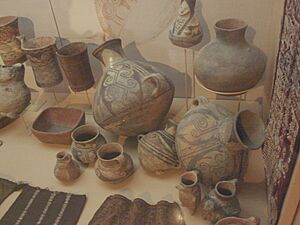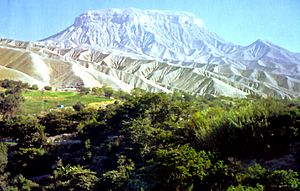Chiribaya culture facts for kids
Quick facts for kids
Chiribaya
|
|||||||||
|---|---|---|---|---|---|---|---|---|---|
| c. 900–c. 1450 | |||||||||

Extent of the Chiribaya culture in the middle of the 15th century.
|
|||||||||
| Location | Atacama Desert | ||||||||
| Official languages | Puquina | ||||||||
| Historical era | Late Intermediate | ||||||||
|
• Established
|
c. 900 | ||||||||
|
• Disestablished
|
c. 1450 | ||||||||
|
|||||||||
The Chiribaya culture was an ancient group of people who lived along the coast of southern Peru and northern Chile. They thrived from about 700 CE until the Spanish arrived in the late 1500s. Their most active period was from 1000 CE to 1360 CE.
The Chiribaya people lived in two main types of areas. Some settled right by the Pacific Ocean, along about 220 kilometres (140 mi) of coastline. Others lived inland in farming communities. These inland areas were in the valleys of rivers like the Osmore and Tambo in Peru, and the Lluta and Azapa Valley in Chile.
Archaeologists have studied the lower Osmore valley a lot. This area was important because bigger empires, like the Wari and Tiwanaku, also settled there. Later, the Lupaca people and the Inca Empire took control. These powerful highland empires needed the warmer, lower valleys to grow crops like maize (corn) and chile peppers.
Contents
Living in the Desert: The Chiribaya Environment
The Chiribaya people lived in the Atacama Desert, which is one of the driest places on Earth. For example, Ilo, Peru, near the Osmore River, gets almost no rain each year (only about .1 inches (2.5 mm)).
So, how did they farm? They used water from rivers and a few springs for irrigation. The rivers in Chiribaya lands started high up in the Andes mountains, about 130 kilometres (81 mi) inland. These mountain areas get more rain.
The ocean nearby was also very important. The cold Humboldt Current makes the Pacific waters rich with fish, marine mammals, and birds. This provided a lot of food for the Chiribaya.
Inland Chiribaya sites were usually built along rivers. This gave them water for farming. However, there wasn't a lot of flat land for crops because of the steep hills. Near the ocean, water for farming was also limited.
Raising Camelids like llamas and alpacas was another key way they got food and materials. These animals were also used to make textiles (cloth).
Who Came Before the Chiribaya?
People lived in the Chiribaya area long before the Chiribaya culture began. Evidence shows humans were there over 9,000 years ago. These early people were part of the Chinchorro culture. They were famous for practicing mummification thousands of years before ancient Egypt.
The Chinchorro people lived mostly by the sea. About 89% of their food came from the ocean. Only a small part came from plants (6%) and land animals (5%). The Chinchorro culture ended around 1100 BCE.
Later, from about 400 BCE to 300 CE, the Huaracane culture brought farming to the inland areas of the Osmore River region. After that, powerful empires like the Wari and Tiwanaku set up colonies in the Osmore valley, influencing the local people.
How the Chiribaya Lived and Worked
The Chiribaya culture wasn't a single big kingdom with one ruler. Instead, it was more like a group of loosely connected communities. Each community had its own local leader. You could think of them like small, independent towns working together.

A key idea for ancient cultures in this region was "verticality." This means they used different areas at different heights (altitudes) to get a variety of goods. For example, people living high in the Andes mountains would set up smaller communities closer to the Pacific Coast. These distant communities would still be connected to their mountain homes.
In the Osmore river valley, there were two main groups of Chiribaya people:
- Pescadores (fishermen) lived near the coast. They focused on fishing.
- Labradores (farmers) lived a few miles inland, at elevations of about 1,000 metres (3,300 ft) to 2,000 metres (6,600 ft). They mainly grew maize (corn) and chili peppers.
These two groups traded their products with each other. They also supplied these goods to the highland cultures. Llamas and alpacas were raised in both areas, but they were likely more important for the leaders in the inland farming areas.
Even the fishermen near the coast did some farming and raised a few animals. They used areas near river mouths and "lomas" (fog-oases) which are places where fog provides enough moisture for plants to grow.
Interestingly, genetic studies show that the Chiribaya people in the lower Osmore River Valley might have been partly descendants of the Wari and Tiwanaku colonists. However, the Chiribaya in Chile's Azapa Valley were more likely descendants of the ancient Chinchorro culture. This suggests that the highland empires didn't have as much direct contact with the Azapa valley people.
The End of the Chiribaya Culture
Around 1360 CE, a huge flood hit the Osmore valley. This flood was probably caused by a strong El Niño event. The flood destroyed many of the Chiribaya's irrigation systems and settlements.
After this disaster, many people left the area. The large irrigation systems were not fixed until the Spanish arrived much later, in the late 1500s. The remaining Chiribaya people likely joined with the Estuquiña people, who lived in the upper Osmore valley.
The area also came under the control of other groups. The Lupaca people from the Lake Titicaca area and the Incas took over in the 1400s and early 1500s.
Chiribaya Dogs
In 2006, archaeologists made an exciting discovery. They found the mummified remains of 43 dogs in a Chiribaya cemetery near Ilo. Some of these dogs were buried with blankets and even food!
These dogs were important helpers. They were used to herd llamas, which were vital for the Chiribaya people. Today, Peruvian authorities are working to get international recognition for modern-day Chiribaya shepherd dogs. These dogs look a bit like a small Golden Retriever and are considered a unique breed.
See also
 In Spanish: Cultura chiribaya para niños
In Spanish: Cultura chiribaya para niños



